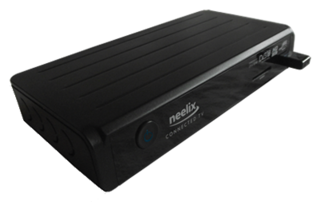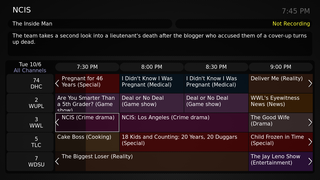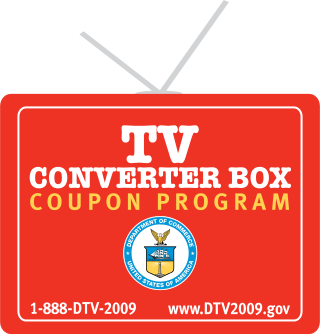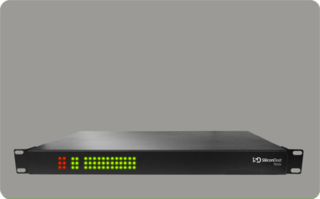Related Research Articles

Cable television is a system of delivering television programming to consumers via radio frequency (RF) signals transmitted through coaxial cables, or in more recent systems, light pulses through fibre-optic cables. This contrasts with broadcast television, in which the television signal is transmitted over-the-air by radio waves and received by a television antenna attached to the television; or satellite television, in which the television signal is transmitted over-the-air by radio waves from a communications satellite orbiting the Earth, and received by a satellite dish antenna on the roof. FM radio programming, high-speed Internet, telephone services, and similar non-television services may also be provided through these cables. Analog television was standard in the 20th century, but since the 2000s, cable systems have been upgraded to digital cable operation.

A set-top box (STB), also colloquially known as a cable box or receiver and historically television decoder, is an information appliance device that generally contains a TV-tuner input and displays output to a television set and an external source of signal, turning the source signal into content in a form that can then be displayed on the television screen or other display device. They are used in cable television, satellite television, and over-the-air television systems as well as other uses.
In telecommunications, a scrambler is a device that transposes or inverts signals or otherwise encodes a message at the sender's side to make the message unintelligible at a receiver not equipped with an appropriately set descrambling device. Whereas encryption usually refers to operations carried out in the digital domain, scrambling usually refers to operations carried out in the analog domain. Scrambling is accomplished by the addition of components to the original signal or the changing of some important component of the original signal in order to make extraction of the original signal difficult. Examples of the latter might include removing or changing vertical or horizontal sync pulses in television signals; televisions will not be able to display a picture from such a signal. Some modern scramblers are actually encryption devices, the name remaining due to the similarities in use, as opposed to internal operation.
Digital cable is the distribution of cable television using digital data and video compression. The technology was first developed by General Instrument. By 2000, most cable companies offered digital features, eventually replacing their previous analog-based cable by the mid 2010s. During the late 2000s, broadcast television converted to the digital HDTV standard, which was incompatible with existing analog cable systems.

A cable television headend is a master facility for receiving television signals for processing and distribution over a cable television system. A headend facility may be staffed or unstaffed and is typically surrounded by some type of security fencing. The building is typically sturdy and purpose-built to provide security, cooling, and easy access for the electronic equipment used to receive and re-transmit video over the local cable infrastructure. One can also find head ends in power-line communication (PLC) substations and Internet communications networks.
Hybrid fiber-coaxial (HFC) is a broadband telecommunications network that combines optical fiber and coaxial cable. It has been commonly employed globally by cable television operators since the early 1990s.
Pirate decryption is the decryption, or decoding, of pay TV or pay radio signals without permission from the original broadcaster. The term "pirate" is used in the sense of copyright infringement. The MPAA and other groups which lobby in favour of intellectual property regulations have labelled such decryption as "signal theft" even though there is no direct tangible loss on the part of the original broadcaster, arguing that losing out on a potential chance to profit from a consumer's subscription fees counts as a loss of actual profit.

CableCARD is a special-use PC Card device that allows consumers in the United States to view and record digital cable television channels on digital video recorders, personal computers and television sets on equipment such as a set-top box not provided by a cable television company. The card is usually provided by the local cable operator, typically for a nominal monthly fee.

Electronic programming guides (EPGs) and interactive programming guides (IPGs) are menu-based systems that provide users of television, radio and other media applications with continuously updated menus that display scheduling information for current and upcoming broadcast programming. Some guides also feature backward scrolling to promote their catch up content. They are commonly known as guides or TV guides.
In broadcasting, channel playout is the generation of the source signal of a radio or television channel produced by a broadcaster, coupled with the transmission of this signal for primary distribution or direct-to-audience distribution via any network. Such radio or television distribution networks include terrestrial broadcasting, cable networks, satellites, IPTV, OTT Video, point-to-point transport over managed networks or the public Internet, etc.

Satellite television is a service that delivers television programming to viewers by relaying it from a communications satellite orbiting the Earth directly to the viewer's location. The signals are received via an outdoor parabolic antenna commonly referred to as a satellite dish and a low-noise block downconverter.

A digital television adapter (DTA), commonly known as a converter box or decoder box, is a television tuner that receives a digital television (DTV) transmission, and converts the digital signal into an analog signal that can be received and displayed on an analog television set. Some also have an HDMI output since some TVs with HDMI do not have a digital tuner. The input digital signal may be over-the-air terrestrial television signals received by a television antenna, or signals from a digital cable system. It normally does not refer to satellite TV, which has always required a set-top box either to operate the big satellite dish, or to be the integrated receiver/decoder (IRD) in the case of direct-broadcast satellites (DBS).

A coupon-eligible converter box (CECB) was a digital television adapter that met eligibility specifications for subsidy "coupons" from the United States government. The subsidy program was enacted to provide terrestrial television viewers with an affordable way to continue receiving free digital terrestrial television services after the nation's television service transitioned to digital transmission and analog transmissions ceased. The specification was developed by the National Telecommunications and Information Administration (NTIA), with input from the broadcast and consumer electronics industries as well as public interest groups.

HDHomeRun is a network-attached digital television tuner box, produced by the company SiliconDust USA, Inc.
Cable television piracy is the act of obtaining unauthorized access to cable television services. It is a form of copyright infringement and a federal crime. Reception of cable television without authorization by a cable operator is forbidden by both federal and state laws. Cable television piracy is usually a class A misdemeanor; if the service is $500 or more, it is classified as a class C felony.

A cable converter box or television converter box is an electronic tuning device that transposes/converts channels from a cable television service to an analog RF signal on a single channel, usually VHF channel 3 or 4, or to a different output for digital televisions such as HDMI.
When a descrambler is added to the Cable Converter Box in the same chassis, it is referred to as a Converter/Descrambler or sometimes a Combination Unit, and is a type of Set-top box, it allows : local broadcast channels, basic cable channels, authorized premium channels, "Pay-Per-View" (PPV), and “Video On Demand” (VOD) services to be viewed. A Combination Converter/Descrambler is generally called a Set-top box or STB it is a single (one-piece) system installed in a single cabinet and represents a single component that is capable of descrambling premium services, like HBO or Showtime, pay-per-view cable channels., Video on Demand, Games or other specialty pay services, and transposes the cable signal for RF output on channel 3 or 4. This unit contains a converter and a descrambler, enclosed in a common box and outputs the signal directly to a TV, VCR, DVR, PC, DVD or video projector.
Zenith Cable Modem was one of the first proprietary cable modems. The two basic models are one operating at 500 kilobits per second (kbit/s), and the other at four megabits per second (mbit/s) with BPSK and approximately a 25% alpha.
Hotel television systems are the in-suite television content presented in hotel-rooms, other hotel environments and in the hospitality industry for in-room entertainment, as well as hospitals, assisted living, senior care and nursing homes. These services may be free for the guest or paid, depending on the service and the individual hotel's or hotel chain’s policy. Generally these services are controlled by using the remote control.
CloudTV is a software platform that virtualizes CPE or STB functionality, enabling pay-TV operators and other video service providers to bring advanced user interfaces and online video experiences such as YouTube and Hulu to existing and next-generation cable television and IPTV set-top boxes and connected consumer electronics devices.
References
- ↑ "Addressability system - US Patent 6070001 Abstract". Archived from the original on 2011-06-12. Retrieved 2008-01-15.
- ↑ "Descrambler". Archived from the original on 2008-01-15. Retrieved 2008-01-15.
- ↑ "Technicolor has closed the acquisition of Cisco's Connected Devices business".
- United States Patent 6070001 Addressability system Patent
- United States Patent 4937865 Cable TV channel security system having remotely addressable traps
- Conditional Access System Indigital Corporation
- ADDRESSABLE CABLE TV SYSTEMS Scatmag.com
- Plug the Revenue Leaks in Your Cable System!, Scientific Atlanta
- Bartlett, Eugene (1990). Cable Television Technology & Operations -HDTV and NTSC Systems. New York, New York: McGraw-Hill, Inc. pp. 8–9. ISBN 0-07-003957-7.